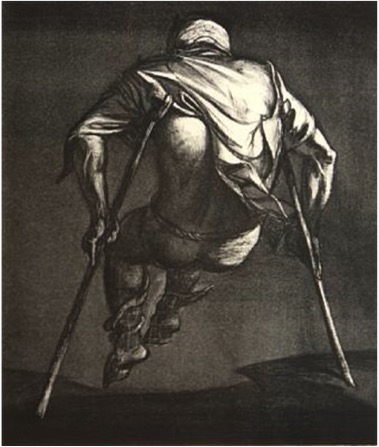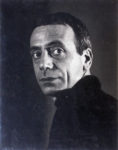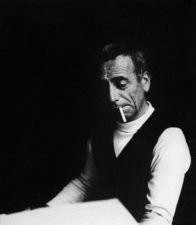
Rico Lebrun
Italian, 1900-1964 (active USA)
Rabbit, 1945
lithograph on paper
14 1/2 x 12 3/8 in.
SBMA, Artist in Residence Fund
1945.5.10

Undated photo of Lebrun
"True lines do not exist in nature; we invent them. They are poetic fiction."
"All creative works of art are fiction. They do not exist in reality. Even the most realistic painting or novel have no existence in reality. They approximate reality. A painting of a rose is never going to match the real rose in the garden. Human creativity does have limits. We can not create the world in which we live. And this is okay. We are not gods. We are not perfect. Sometimes it is best to accept our limitations than to become frustrated in our attempts to overcome our limitations."
- Rico Lebrun

Lebrun in 1960's
COMMENTS
I. BIOGRAPHY
Rico (Frederico) Lebrun was born in Naples, Italy on December 10, 1900. At the age of 17, he graduated from secondary school and began a two-year service in the Italian Army during World War I. Upon his discharge, he attended the Industrial Institute in Naples and began his first formal art classes at the Naples Academy of Beaux Arts. Through his work as a designer for a stained-glass factory in Naples, Lebrun was offered a contract to work at the Springfield, Illinois branch of the Pittsburgh Plate Glass Company.
After his contract ended, he moved to New York City, where he found work as a commercial artist drawing advertisements and fashion plates for such magazines as Vogue, Fortune and The New Yorker. Earning a moderate salary, Lebrun was able to take an extended trip to Italy where his passion for fine art was rekindled. During his six-year stay abroad, he studied the fresco paintings of Italian Renaissance artist Luca Signorelli (1441-1523). In 1936, he returned to New York City, where he took a teaching position at the New York Art Students’ League.
This year marked a turning point in Lebrun’s career as he decided to stop working as a commercial artist and return to the fine art of mural painting. Soon after this decision, Harvard University commissioned Lebrun and his fellow artist friend Lewis Rubenstein (b. 1908) to complete a mural on the top level of the Fogg Art Museum. Though the mural was removed shortly after its completion, the designs earned Lebrun a prestigious Guggenheim fellowship in 1936, which he won again in 1937.
In the following year, Lebrun moved to Southern California. Once in Santa Barbara, he found a great deal of support from the local art community. While spending time with artist friend Channing Peake (1910-1989), Lebrun gained the friendship of Donald Bear, who was the new Director of the Santa Barbara Museum of Art (SBMA). Bear was responsible for organizing Lebrun’s first solo-exhibition, which was later followed by a successful string of national exhibitions. Between 1938 and 1944, Lebrun taught in Los Angeles at the Chouinard Art Institute and the Walt Disney Studios. During this time, Lebrun became a leading modernist figure in the Los Angeles area, even gaining the strong support of conservative Los Angeles Times critic Henry J. Seldis. Moreover, Lebrun was offered a prominent position as artist-in-residence at SBMA.
In 1947, he began to devote his art to themes dealing with religious experience and human suffering. For the next three years, Lebrun worked on the Crucifixion series, preparing well over two hundred drawings and paintings. The series culminated in a large exhibition at the Los Angeles County Museum of Art that later traveled to the De Young Museum in San Francisco, while the Crucifixion triptych ultimately found a home at Syracuse University in New York. After an extended trip to Mexico, Lebrun returned to Los Angeles, where he worked on a series based on the horrendous atrocities that took place at the Nazi concentration camps at Buchenwald and Dachau. Lebrun later commented that this series was a “form of remembrance and prayer… changing what is disfigured into what is transfigured.”
In 1958, he spent a year as a visiting lecturer at Yale University before returning to Italy to become artist-in-residence at the American Academy in Rome. During his time abroad, Lebrun outlined his ideas for a commissioned mural at Pomona College. In little less than half a year, he completed the enormous Genesis mural, which still stands on the college campus today. Following the project’s completion, Lebrun took on a position as faculty member at the University of California at Santa Barbara and for the first time devoted his career to sculpting. In the midst of this new endeavor, the sixty-three year old artist died quite suddenly at his Malibu home, after being diagnosed with cancer the previous year. His wife Constance and their son, David, survived him.
II. AN ANALYSIS OF THE ARTIST'S WORK
Much of Rico Lebrun’s art is somber in appearance and often addresses death and human suffering. Devoting a large portion of his career to themes such as the crucifixion of Christ and the Holocaust, Lebrun transformed these events into the grandest of dramatic tragedies. As Lebrun stated, they tell a story of “man’s blindness and inhumanity.” Evident in the very line of his disfigured forms and the dark, monochromatic appearance of much of his work, Lebrun adhered to his own artistic philosophy that “the very fact that a great work of art depicts the negative side in the fight for humanity is in itself a fulfillment.”
For Lebrun, drawing remains at the heart of his work. He made hundreds of studies in preparation for his large-scale paintings and murals. Lebrun’s Crucifixion cycle was the most recognized work of his career. His Magdalenes and Women of the Crucifixion are regarded as the most striking images of the series and take prominent positions in the original installation. For Lebrun, Mary Magdalene was the pivotal figure to express his humanist philosophy; surrounded by evil and decay, she finds herself in perpetual grief over the absence of lasting good. Lebrun emphasized that his “crying women are, like all mothers, empty houses pierced by screams, for I have never seen pretty sorrow.”
In 1962, Lebrun turned his full attention to sculpting stating, “there was no place to carry images except into a third dimension.” Through bronze casts and reliefs, he translated his dual philosophy of despair and hope. Contrary to the idealized, opulent bronze sculptures of antiquity and the Renaissance, Lebrun’s fragmented and partially formed figures are the tortured ruins of a doomed world. His headless bodies and bound figures appear to bear the transgressions of humanity, while his busts carry their eyes towards the heavens in search of a merciful savior. Up to the last moments of his life, Lebrun continued to fulfill his duty as an artist believing that it was up to his profession to express a criticism about the world around.
sullivangoss.com
